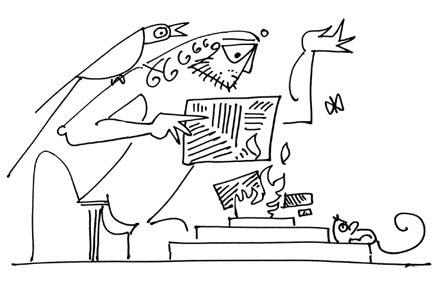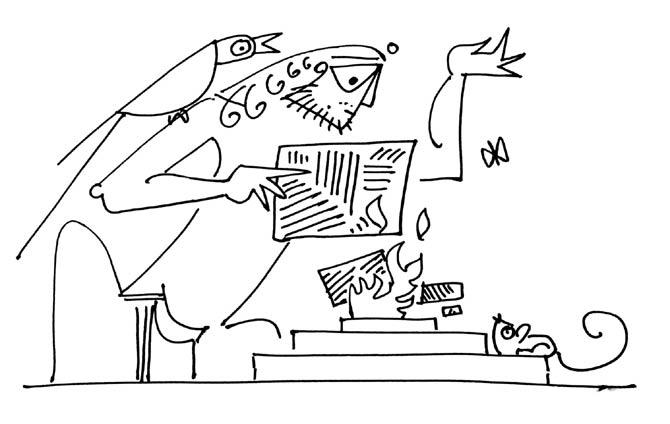Many of the fairy tales told around the world can be traced to India, leading many scholars to suggest that India is the home of stories

 Many of the fairy tales told around the world can be traced to India, leading many scholars to suggest that India is the home of stories. The original collection known as Brihat-katha, or the ocean of stories, was written in a language called Paisachi, the language of ghosts, which is neither Sanskrit nor Prakrit. It is now lost. However, part of it remains, as Katha-sarit-sagar.
Many of the fairy tales told around the world can be traced to India, leading many scholars to suggest that India is the home of stories. The original collection known as Brihat-katha, or the ocean of stories, was written in a language called Paisachi, the language of ghosts, which is neither Sanskrit nor Prakrit. It is now lost. However, part of it remains, as Katha-sarit-sagar.
ADVERTISEMENT

Illustration/Devdutt Pattanaik
The story goes that Shiva narrated these tales to his wife, Shakti. They were overheard by Shiva’s attendants, the ganas, who passed it on to the ghosts, Pisachas. They were, in turn, overheard and understood by Gunadhya, who had sworn never to speak in Sanskrit and Prakrit, having lost a bet to his king. Gunadhya wrote the stories down using his blood as ink and gave it to king Shalivahana, but the king found the language strange and felt Gunadhya was simply a madman who claimed to speak the ‘language of ghosts’. So Gunadhya, with a heavy heart, began reading the stories aloud in the forest to the birds and the beasts; burning the manuscript page by page. The king, who had rejected the manuscript, happened to be in the forest hunting, and observed the birds and beasts listening spellbound to the strange language of a sage. He realised that Gunadhya was not madman as he first suspected, but was, in fact, truly telling a story known only to ghosts until then. He stopped Gunadhya and saved what remained of the book. Of the seven sections of the great narrative, only one remained from which all the fantastic adventure stories of the world have come into being. These stories had no religious leanings but were eventually absorbed and turned into Buddhist, Jain and Hindu stories.
Thus, from here we have the story of Rishya-shringa who was raised as a hermit and grew up with no knowledge of women. This story is found in the Buddhist Jatakas, in the Jain Vasudevahindi and the Hindu Ramayana. Similarly, there is the story of Sudasa, who loved to eat, and one day, accidentally ate the meat of a human and became a cannibal until he was killed, or cured, by a Jain hero, or Buddhist sage. Then, there is the cautionary tale of the courtesan, who ends up marrying her own son who she had abandoned at birth, found in Jain, Buddhist and Puranic lore. There is the story of haughty Vasudatta who loses her husband and her children to various natural calamities, and ends up either as a Jain or Buddhist nun. Or the story of the hospitable female bird captured by a fowler who asks her husband to kill himself so that they can feed their ‘guest’, the fowler. This story is found in the Shanti Parva of the Mahabharata, but also makes it to the Buddhist Jatakas as a story of compassion and generosity and forgiveness. The story of two mothers fighting over a baby until the true mother lets go of the child to prevent it from being cut is well-known. In Jain traditions, Krishna’s father, Vasudeva, is the wise king who solves the problem. In Buddhist traditions, it is a Bodhisattva. And in the Bible, the king who solves this problem is Solomon!
The author writes and lectures on relevance of mythology in modern times. Reach him at devdutt@devdutt.com
 Subscribe today by clicking the link and stay updated with the latest news!" Click here!
Subscribe today by clicking the link and stay updated with the latest news!" Click here!







